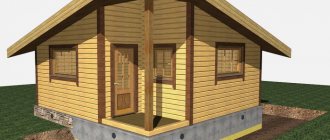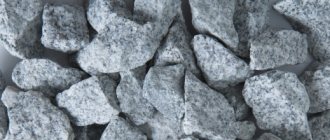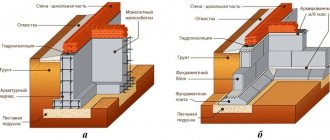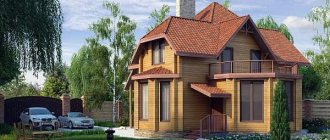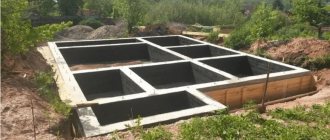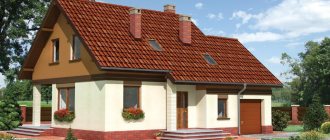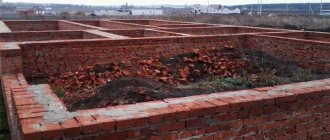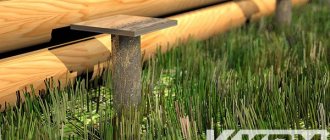The foundation of a building is the most important part of the structure.
The characteristics of the building depend on its quality and reliability. When constructing a foundation, it is necessary to strictly adhere to technology, otherwise it will quickly begin to collapse, which will entail deforming processes in the walls and ceilings.
When constructing a strip foundation, professional builders pour a sand or crushed stone cushion onto the bottom of the trench.
Why do you need a pillow under the foundation?
Those who are thinking about making the foundation for the building themselves should pay attention to clearly defined construction rules regarding this issue.
First of all, it is important to comply with all the requirements for such a stage of work as installing a sand and gravel cushion. In addition to a pillow made of a combination of sand and gravel, foundation pillows made of concrete and crushed stone are common.
As a rule, a concrete pad is required only when making a reinforced belt under FBS blocks or when additionally expanding the foundation walls
In addition to a cushion made of a combination of sand and gravel, foundation cushions made of concrete and crushed stone are common. As a rule, a concrete pad is required only when making a reinforced belt under FBS blocks or when additionally expanding the foundation walls.
Sand and gravel cushion is made on construction sites with weak-bearing soil
It is important to remember that under no circumstances should you use sand dust or fine-grained sand to form it. The ready-to-use mixture must consist of gravel and sand, which have average particle sizes
After a pillow made from this composition is laid, it will give minimal shrinkage, to ensure which it is necessary to carefully compact it. Such a base for the foundation will perfectly withstand the load not only of a medium-sized house built from frame building materials, timber or logs, but also of a large building, for example, with an attic or second or third floor.
When constructing a sand and gravel support, you can use the following work option:
- dig a trench of the required width and depth down to the level of dense layers of soil;
- in the ditch, which is thus obtained, it is necessary to fill in coarse-grained river sand;
- sand should be poured in layers and in small portions. Each layer should be 15 cm thick;
- after laying each new layer, it must be spilled with water;
- all layers are compacted using special tamping equipment;
- the finished support should have a width 10 mm greater than the planned width of the future building.
The need for a sand-gravel cushion in construction, not only of low-rise buildings, but also of larger ones, is determined by its relatively affordable cost, high degree of durability and the ability to carry out the work with one’s own efforts, without the help of professional builders. However, it should be taken into account that such little things as cleaning the trench after an excavator, filling sand and gravel with buckets or a wheelbarrow, and manually watering all layers with water will require workers to invest serious physical effort. It may be entirely justified to try to involve family members or friends in the process.
Why is bulk material laid?
To briefly answer the question of whether it is always necessary to make a sand cushion under the foundation, the answer will be negative. Bulk material under the sole is needed to perform three functions, which are described below.
Block foundation
The construction of a sand cushion is an event inherited from Soviet times. At that time, the foundation of the house was mainly made from standard factory-made elements, FBS foundation blocks. According to SP 50-101-2004, for a prefabricated supporting part, preparation from bulk material is mandatory.
For a prefabricated foundation, the pillow acts as a leveling base.
The preparation from sand here is justified by the fact that when installing individual elements on the foundation soil, which has even slight differences, they may become distorted. The blocks are not interconnected enough and cannot cope with the uneven ground beneath them. It follows that the first function of the sand cushion under the foundation is the need to create a flat surface for the installation of individual elements. In addition, bulk material, unlike the soil available on the site, can easily adapt to the shape of the supporting part of the building and prevent its displacement during operation.
Monolithic concrete fills all uneven ground.
Heaving soils
Frost heaving is a phenomenon that frightens everyone who is involved in construction or who is planning to build a private house with their own hands.
It is important to understand the causes of this problem. It occurs when two factors are present simultaneously:
- water;
- low temperatures.
If you exclude at least one of them, heaving does not occur. Clay foundations are especially prone to this phenomenon. According to SP 50-101-2004, a cushion made of non-heaving (conditionally) materials (that is, of coarse-grained or medium-grained sand or coarse-grained material) is required to be provided for foundations constructed on heaving soils. In this case, only non-buried or shallow-buried supports are considered. Thus, the rise of water from the soil to the base of the building is eliminated, that is, one of the factors for frost heaving is eliminated.
Essentially, a sand cushion protects the sole from rising capillary moisture, which can lead not only to heaving, but also to corrosion of the reinforcement. In most cases, this property is not relevant, since modern concrete mixtures include special additives that increase the resistance of the material to moisture penetration, and only a protective layer is needed to preserve the reinforcement.
https://youtube.com/watch?v=oCBtt4-1d28
If you make a buried foundation, the support of which occurs lower than the freezing thickness of the soil, the second factor for the occurrence of heaving is eliminated - temperature. It is worth remembering that the soil itself is not a source of cold, it comes from outside from the atmosphere, so the deeper the base of the house is located, the higher the temperature next to it in winter. In this case, preparation for protection against backlash is not necessary, since there is no reason why it should be provided. The only exceptions are those cases that involve the presence of other reasons.
Presence of weak soil
Sand preparation will be required if the geology of the site includes fill soil. Such a foundation has a loose structure and is highly not recommended for erecting slab, strip or column foundations on it. In this case, you will need to replace part of the soil yourself. Sand is used as a replacement material.
This reason leads to increased labor intensity of work. The thickness of the layer, which will increase the reliability of the base, can be quite large, sometimes the values reach 1.5-2 m. When laying, the sand must be compacted in small layers (15-20 cm).
If we summarize the reasons why you need to prepare sand with your own hands for the foundation, we can say the following:
- alignment for prefabricated structures;
- elimination of capillary moisture in case of insufficient depth of the underground part of the building in heaving soil (MZLF, shallow slab);
- replacing a loose foundation prone to shrinkage with a more durable one.
In other cases, it is useless, and sometimes can be harmful:
- if the soil on the site does not allow water to pass through well (clay), then all the moisture will accumulate in the sand preparation, like in a trough, which will lead to excessive moisture in the soil near the foundation;
- sand or gravel does not prevent water vapor from penetrating through the bottom; because of this, condensation can form on the bottom of the sole, which negatively affects the structure.
Laying the reinforcement cage
When the formwork is ready, concrete mortar is poured into it. When deciding how to make a concrete pad for the foundation, we must not forget about the reinforcement cage, which helps increase the strength of the cushion. When the concrete is completely poured into the formwork to the required level, two rows of steel rods are laid along the entire perimeter of the base pad.
The reinforcement is laid on top of the still wet concrete that has not had time to set at a distance of 15 cm from the formwork walls. Next, they need to be sunk into the concrete solution to a depth of about 20 cm. In order not to leave air bubbles in the solution that were formed as a result of immersion of the rods, the concrete is carefully bayoneted.
At the last stage of installing a concrete pad, it is necessary to carefully level the surface using tools. The surface of the base is then rubbed. This ensures that all dust and dirt after removing the formwork are removed from the surface of the cushion easily and simply.
Most often, the adhesion of the sole and the foundation is achieved through reinforcement bars, which are left in a vertical position to a height equal to the height of the foundation itself.
Before dismantling the formwork, it is advisable to mark the position of each corner of the future base on the upper edge of the cushion. This will be a guide when it is necessary to install the formwork for the construction of the foundation itself.
Which is better sand or crushed stone
The requirements for preparing the foundation pit for the foundation require strict instructions in the construction project based on an analysis of the bearing capacity and properties of the parent soil.
The best preparation for a strip foundation or monolithic slab is lean concrete, and only in some cases is it possible to replace concrete with sand, gravel or ASG to reduce overall costs. At the same time, sand has a wide range of advantages and is more practical.
Gravel is suitable only in cases where high throughput is required when it is necessary to arrange a drainage layer with low water capacity. At the same time, it is difficult to isolate the bedding from the volume in which the foundation will be poured.
The gravel backfill goes well with pile foundations, where it is enough to remove excess moisture from under the foundation of the house, and at the same time there will not be a significant load on the backfill itself.
Under strip foundation
By definition, sand bedding is needed only when ready-made reinforced concrete slabs and blocks are used in order to distribute the load evenly along the base plane.
With the help of sand it is easier to level the bottom of the pit, and tamping gives the sand the necessary density and load-bearing capacity.
However, this is only relevant if it is possible to place a massive vibrating plate in the trench for mechanical compaction of sand. In most cases, it is safer to use a lean concrete footing to level the base and prepare it.
Sand is also relevant in case of significant differences in height along the bottom of the prepared trench. To reduce costs and reduce the volume of solution for the concrete base, sand or crushed stone is added with layer-by-layer compaction and moistening.
Under a monolithic slab
It is important to strictly level the base of the pit and prepare the soil for installation of the reinforcing frame and pouring. Either lean concrete or sand compacted in layers is used.
stages of construction of a monolithic foundation
Sand is mainly used in cases where it is necessary to significantly raise the bottom of the foundation pit after removing the entire fertile soil layer to the base of the parent soil.
When forming the bedding, it is important to pre-distribute trays for water drainage, communication lines that will pass through the foundation slab, and also mark the required planes of the future foundation. According to the requirements, a base is formed under the monolithic slab not strictly in one plane, but with a slight elevation in the center of the building and with a slope of 2-3% in all directions, for effective removal of moisture from the substrate of the future foundation
According to the requirements, a base is formed under the monolithic slab not strictly in one plane, but with a slight elevation in the center of the building and with a slope of 2-3% in all directions, for effective removal of moisture from the substrate of the future foundation.
Particular attention is paid to the quality of sand compaction. Thus, the density of the backfill for the foundation should be from 1.65 t/m3 and preferably not less than the density of the parent soil with an error within 0.05 t/m3
The height of the backfill is determined as the difference between the level of the bare base of the soil after removal of the fertile layer and the design level of the foundation base.
Under a pile foundation
The backfill primarily performs the function of drainage to drain groundwater, and also acts as a substitute for the fertile layer of soil in order to remove the volume of material containing organic or combustible inclusions from under the foundation.
backfill device for pile foundation
For these purposes, it is best to use large and medium gravel and crushed stone. Expanded clay bedding is often used, which further increases the thermal insulation properties of the base.
What crushed stone is best to use?
The foundation structure will be reliable if you choose the right material for it. Crushed stone is produced by crushing gravel, boulders, and rock stones. Types of crushed stone:
- Gravel is very durable, with low background radiation. It is obtained by sifting rocks, as a result of crushing raw materials using special equipment. Its price is low.
- Granite is more durable and is used more often in civil engineering. Its processing is simple, and it can withstand considerable loads. Obtained as a result of blasting rocks and subsequent processing. For pouring foundations, as well as as a raw material for reinforced concrete blocks, its use is considered ideal.
- The cheapest is crushed limestone, which is not particularly good in terms of performance characteristics, although it tolerates low temperatures well. Limestone rocks are used as raw materials.
Crushed stone with a fraction of 20-40 mm can be considered the most common when constructing a base for a foundation; its strength is M1200 with high frost-resistant characteristics. A cheaper option is crushed stone obtained by crushing old concrete.
The most expensive option is granite. It will be able to support any building and ensure its stability over a long period of time, while the foundation will not change.
Concrete preparation for the foundation and its functions
Before you begin building the foundation of your future structure, it is necessary to carry out a set of preliminary preparatory work. So first you need to make preliminary calculations. In the second stage, you need to thoroughly clear and prepare the area for the construction of the foundation. Your next action should be to carry out preliminary preparatory work before constructing the foundation (constructing a cushion for the foundation using lean concrete or well-compacted crushed stone).
There are special technological construction rules that strictly regulate the technology of work on laying a cushion under the base and the thickness of the layers of materials used for construction
Therefore, during construction, it is important to adhere to the established requirements and standards, which are enshrined in the relevant SNiP
The footing is intended for:
- Protecting the concrete mass from possible leakage of the cement mixture.
- Leveling the negative impact of forces from the soil (redistributes the forces arising in the soil).
- Providing additional convenience in the process of reinforcing the structure being built.
There are two types of concrete preparation for the foundation: crushed stone and concrete. The first type of pillow will be much cheaper for you, since the price of crushed stone is much lower than the price of concrete, and you will also save a lot on cement
Please note that the crushed stone layer should be about 20 cm and be thoroughly compacted. It should also be emphasized that this method is not particularly reliable, since the substrate has insufficient rigidity
The footing is used for the construction of strip and slab structures. Please note that according to the norms and regulations, concreting must be carried out with concrete of at least grade M50, and before laying the concrete mixture, a crushed stone and sand cushion must be laid out.
So, if the laying of the pillow is completed, we proceed to the construction of formwork for the base with a height of about 30 cm. Then we will begin laying metal rods to ensure the strength of the structure. At the next stage, we fill the structure with concrete mortar. And the last step will be to compact the concrete pad using a deep vibrator.
How to make a pillow for a foundation
The general requirement for pillows of all types: the width is always slightly larger than that of a concrete strip; an indent of about 20 cm is made in each direction. What is required for the device:
- river sand, clay, crushed stone;
- marking cord;
- bayonet and shovel;
- wheelbarrow, buckets;
- hose from a well or well;
- vibratory rammer.
Let's look at the technical features of laying different pillows.
What kind of sand is suitable for a sand bed?
You should choose sand of medium or coarse fraction. Dust-like is not suitable, because it does not compact well, is easily saturated with moisture, and the layer becomes unstable.
The second condition is the purity of the material. Large stones, organic impurities, and clay should be excluded. The best option is washed river or quarry sand. The purity of the fraction can be determined using a simple test: pour into a transparent vessel, add water and stir. Clean sand settles to the bottom, clay inclusions form turbidity. If the water remains clear or is slightly cloudy, sand can be used for construction purposes.
The thickness of the pad under a strip foundation is usually 25 cm. For a leveling pad on good soil, 15-20 is enough. The poured sand is carefully leveled, moistened and compacted with a vibrating plate. When wetted, the mass of the layer increases, it settles under its own weight and becomes compacted.
What crushed stone is needed for the gravel bed?
Types of crushed stone:
- gravel. Affordable cost, high strength, low background radiation;
- granite. The most durable, designed for high loads. Minus - it accumulates radiation, although on a scale that is not hazardous to health;
- lime. The cheapest, frost-resistant. In terms of strength it is inferior to others.
Budget option: instead of crushed stone, use broken bricks, of which you get a lot when transporting material for brick houses and fences. Another way to rationally use waste is to use crushed old concrete in the construction of the cushion.
For pillows, a fraction of 20-40 millimeters is usually used. In the lower layers the gravel is finer, in the upper layers it is larger. River sand is poured as a substrate under the gravel, up to 15 centimeters. The layer must be compacted and leveled. Next - crushed stone, up to 25 cm. This is also compacted with a vibrating plate. The last layer reaches the zero level of concrete.
Structure of a mixed sand and gravel bed
- The bottom of the pit or trench is paved with rubble stone - small cobblestones (from 15 cm in diameter). Depending on the expected load on the foundation and the depth of the pit, there may be two layers of rubble.
- Pour a gravel layer 10 centimeters thick (optimally 20 cm).
- Pour sand so that it completely covers the gravel.
- Spill water.
- If necessary, add more sand and water again. The procedure is repeated until a continuous sandy “crust” remains on the surface after the spill.
- Compact with a vibrating plate. In its absence, you can use a homemade tool: a steel plate with a rod welded to it with handles for ease of work.
- After compaction, the area is filled with water again.
In some cases, before laying the first (cobblestone) layer, a layer of clay up to 10 cm is placed on the bottom and compacted. The clay layer is waterproof and serves as an additional barrier to groundwater (but does not eliminate the need for design waterproofing).
How to pour a concrete foundation pad?
At the first stage, the soil is thoroughly compacted. Then crushed stone is poured in a layer of up to 10 cm and also compacted. Next, formwork is installed and concrete is poured.
Like the main foundation, the pillow can be reinforced for strength. An 8mm rod will do. Basic filling rules:
- the area should be approximately 15 cm larger than the area of the main foundation on all sides;
- reinforcing bars protrude vertically from the cushion by 20-30 centimeters; they connect the structure with the main foundation.
Height and thickness parameters, waterproofing layer
The height should be three times the width of the tape. But when working on weak heaving soils, the base needs to be made higher, sometimes up to 80 cm. Since the height of one layer should not be more than 30 cm, in cases where high backfill is needed, several alternating layers should be used. The bottom layer is sand.
The width of the pillow should be 30 cm greater than the width of the tape . A well-designed bedding protrudes under the tape by 15 cm on each side. The reserve is needed for the stability of the foundation and the convenience of pouring it.
The pillow along with the foundation tape must be protected from the effects of ground moisture. In areas with wet soil and high underground flows, a waterproofing lining under the base may not be enough.
For maximum protection, the pit is lined with roll waterproofing around the entire perimeter before laying the cushion. It is placed on the bottom, pressed against the walls of the trench, and brought to the surface of the earth.
Selecting material for a sand cushion under the foundation
The best option for installing a sand base under the foundation structure is considered to be gravel or coarse sand. The first is characterized by a significant particle size (0.25 - 5 mm) and the highest load-bearing capacity. Coarse sand has a fraction of 0.25 - 0.2 mm and is capable of withstanding no less severe loads. A positive feature of gravelly and dense coarse sand is that the material does not lose properties depending on moisture and its quantity and fully retains its functional qualities.
Fine-grained sand contains many dust particles and is closer in characteristics to clay soils. When saturated with water, it loses strength and has a tendency to heave. For this reason, its use for a sand cushion is unacceptable.
Is it necessary?
Some private developers, for whom cost-effective construction is important, believe that it is not necessary to lay a cushion under the foundation. They believe that if the house is built on dense soil, they can do without it.
In fact, it is a mandatory element of the strip foundation, because:
- Ensures uniform distribution of the impact of construction on the soil.
- Prevents foundation subsidence.
- Acts as an additional barrier between the base of the building and groundwater.
Is a sand cushion needed for, for example, a strip foundation on clay? A sand or crushed stone cushion is needed during the construction of any object, regardless of:
- soil quality,
- dimensions of the building,
- foundation depths,
- other factors.
It provides stability and strength to the base. At the same time, it protects it from moisture and compensates for soil movements, keeping the base of the building motionless.
Stages of work execution
There are three options for building materials that are used to create a foundation cushion:
- Sand. Here, river and quarry materials are used;
- Crushed stone and gravel;
- Concrete solution.
The second option is considered the most durable of all presented and the simplest in terms of design. Creating a crushed stone cushion is possible on your own. The process of creating a substrate is divided into stages:
- A recess is made into which materials will be poured;
- Sand is poured onto the bottom. The layer should not exceed 15 centimeters. Now it needs to be leveled. Tamping is required, done with a small addition of water;
- Now crushed stone is poured on top. Fractions within 20-40 millimeters. In this case, the layer is up to 25 centimeters. It also needs to be compacted. It is recommended to use a vibrating plate here, since doing this manually will be problematic.
The pillow is ready. This type of substrate is often used under a strip-type foundation for the construction of brick and stone buildings with a small number of floors.
Benefits of a sand pillow
For budget-conscious builders, a sand cushion is perfect. Among the advantages, its low cost and availability in almost all regions . The question of which sand is suitable for a foundation cushion is not asked by chance. It is recommended to use sand with coarse or medium fractions . The quality of the foundation base depends on what kind of sand is used underneath it.
If the sand is dry, it needs to be moistened during the compaction stage . Wet sand is compacted immediately using special rollers or tampers. The trench for the foundation has been dug, leveled, and has steep walls, which means it’s time to pour in sand. The thickness of the layer depends on the type of structure , and its size is present in the design documentation.
Sand is poured in layers, with layer-by-layer compaction, and watering if necessary. The quality of the compaction is checked by the materials at hand, or, in this case, it would be more appropriate to say, by the “foot” material. You need to walk along the resulting prism, and if no footprints are visible, the compaction is considered sufficient . Before further pouring of the foundation, waterproofing work is carried out. They involve laying a special film or bitumen on the sand. For a one-story building, a sand cushion is perfect for the foundation. But this material also has a drawback.
When constructing multi-storey buildings, it may not withstand the load from the building. At the foundation calculation stage, designers choose whether sand or something else will be used. In addition, pressure on the sand gradually turns large grains of sand into small ones, and small ones into dust . And the sand cushion stops performing its functions, with all the ensuing consequences.
Return to content
Types of pillows
Depending on whether the cushion is made under a slab foundation (FBS) or under concrete, the optimal material for the layer and its main characteristics (thickness, height, hardening, etc.) are selected. Before arranging a cushion, it is necessary to carefully study the soil at the site and perform all calculations. Traditionally, the foundation cushion is made of sand, crushed stone, precast/monolithic concrete.
Sandy
When thinking about how to make a concrete cushion, sand is most often chosen as the easiest to work with and the most affordable material.
When is a sand cushion relevant:
- The building is supposed to be built as a one-story building, which makes the opportunity to reduce waste quite justifiable.
- The house is built from lightweight material.
- The groundwater level is deep (provided that the groundwater is close, drainage is required).
When calculating the foundation cushion, you need to take into account that only coarse sand is suitable for this type of work. Fine sand cannot be used.
Things to remember when filling your pillow:
- The surface of the pillow should be made as smooth as possible, checking with appropriate tools.
- The layer of sand must be compacted thoroughly and for a long time.
- The optimal thickness of the sand cushion is 20-40 centimeters.
From crushed stone
Crushed stone is usually used where significant loads on the foundation are expected. Crushed stone is chosen in different fractions, rocks can also be anything. But the most durable support will be crushed granite of the middle fraction.
How to make a foundation cushion from crushed stone:
- First, the surface of the trench or ditch is sprinkled with a small layer (5-10 centimeters) of sand to ensure a tighter fit of the crushed stone to the ground.
- The sand is carefully leveled and compacted well.
- Crushed stone of the required fraction is poured in a layer, the thickness of which is up to 20 centimeters.
- The crushed stone backfill is carefully compacted using the appropriate tool.
The crushed stone cushion should be at least 30 centimeters wider than the base, which will ensure stability and the ability to withstand the considerable weight of the building.
Concrete
The concrete pad for the house can be prefabricated or monolithic. The team is made from special trapezoidal blocks produced in a factory. This is the most reliable support for large stone houses. True, the cost of this option is quite high.
How to lay prefabricated concrete pads:
- First, carefully level the soil.
- Sand is poured in a layer of up to 50 centimeters (the exact figure depends on the characteristics of the construction site and the soil).
- The foundation blocks of the pillow are installed.
A reinforced concrete pad made in this way is very strong, durable, and capable of withstanding severe loads. In Moscow, purchasing blocks will not be difficult, as in the regions. Manufacturers offer products of different prices, parameters, with or without delivery to the site.
How to pour monolithic concrete pads under the foundation:
- Preparing the soil surface - leveling, removing everything that gets in the way.
- Filling with crushed stone in a layer maximum 10 centimeters high.
- Compacting crushed stone using a vibrating plate.
- Installation of wooden formwork around the entire perimeter of the foundation. The height of the structure is equal to the thickness of the concrete layer, the upper level coincides with the zero level of the base.
- Laying horizontal and vertical reinforcement frames to strengthen the structure.
- Pouring concrete, compacting the layer, waiting for drying time and full strength gain.
Concrete foundation pads are made from C12-C15 concrete. You can pour it not only into the formwork, but also directly into the ground. The height of the reinforced layer is at least 40 centimeters in order to withstand compressive loads and not deform.
Reinforcement is usually made using steel rods, which are connected with knitting wire and placed horizontally and vertically. By tying the rods together, it is possible to ensure their immobility inside the formwork before and monolithic structure after pouring.
Kinds
Usually the pillow is made of sand. When leveling the bottom of the trench, sand is also used, but this is not a cushion, but simply an auxiliary layer of 2-3 centimeters. In addition to sand, crushed stone or concrete mortar is used for embankment.
Sand pillows are the most economical . They are used in the budget construction of small buildings. You need to purchase coarse sand, otherwise the base will not be hard enough.
It is necessary to pour sand in layers, carefully compacting each layer 10 cm using water. Sand mounds are made from 20 to 40 cm in height. The surface must be perfectly leveled.
Under a house on soft soil, a cushion of sand alone may not be effective. Crushed stone is added to it, which makes the base resistant to shrinkage .
The mixed base is stronger, more durable, and better protects against moisture. When building private cottages, it is recommended to use such combined pillows.
Crushed stone and sand can be mixed . But it is better to pour the materials in layers - first a layer of sand, then crushed stone. The layers should be up to 20 cm. The filled sand must be carefully compacted and leveled. After pouring crushed stone, you need to walk over it and also level it, check whether voids have formed.
The pillow can only consist of crushed stone. A gravel or granite variety is used. Usually gravel is purchased because it is cheaper and more convenient to use. Crushed stone is more stable than sand. It absorbs less water and has a longer service life. It is used in the construction of two and three-story cottages.
There is also a concrete option . In fact, the concrete subbase is an additional element of the foundation. It is installed on top of a fairly high sand cushion (up to 50 cm). Concrete is a thin monolithic reinforced layer of concrete on which the main part of the foundation is built - formwork, reinforcement cage, pouring concrete.
Another option is to lay ready-made concrete slabs instead of a poured layer of concrete. The concrete base is quite expensive. Rarely used in low-rise construction. But in some cases it becomes the only way to arrange the foundation.
For example, using a concrete pad, you can build a large massive house on a site with problematic soil.

